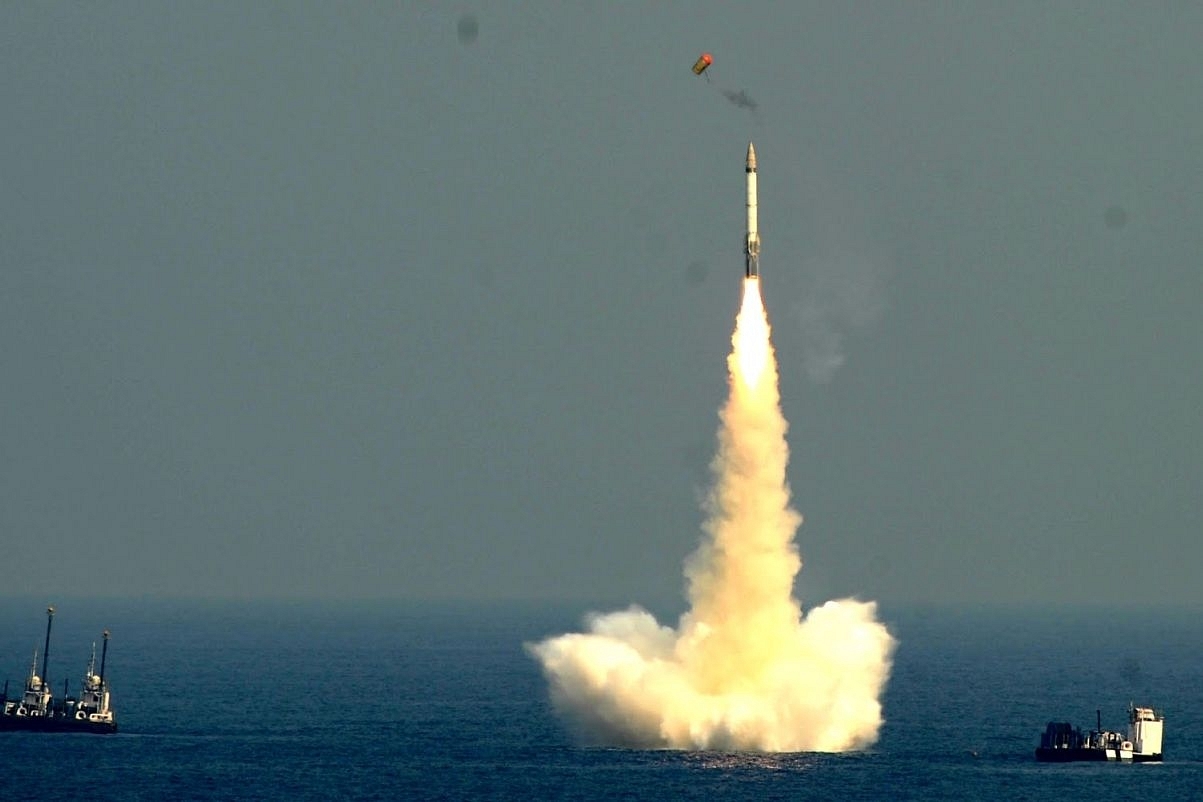Defence
Why The Latest Test Of India’s K-4 Submarine-Launched Ballistic Missile Is More Significant Than You Thought
- With the 3,500-km range K-4, India will be able to target parts of China, including Beijing, and all of Pakistan, from the northern parts of the Bay of Bengal.

A representative image of an SLBM launch.
When INS Arihant, India’s only in-service nuclear submarine (ballistic missile submarine or SSBN) completed its first deterrence patrol in November 2018, the country achieved a significant milestone — operationalisation of the triad, the capability to launch nukes from land, air and sea. However, this was largely symbolic, and one of the reasons behind this is the missile the boat carried.
The Arihant, during the deterrence patrol, was armed with Sagarika K-15 (or B-05) submarine launched ballistic missiles (SLBMs), of which it can carry 12. The K-15 is said to have been operationalised after being “secretly test-fired back-to-back” from INS Arihant in August 2018, just ahead of the deterrence patrol.
For a credible at-sea deterrence, a country’s SSBNs must be capable of, among other things, targeting population and industrial centres of the adversary. In India’s case, this means that the Indian Navy’s SSBNs must be capable of holding at risk cities not only in Pakistan but also in the Chinese mainland.
With the K-15’s 750-km range, targeting Pakistani cities would be possible only from the Arabian Sea, which lowers down the area the Pakistan Navy would have to keep watch over if it was trying to locate an Indian SSBN. This becomes more problematic when one factors in the fact that India has only one SSBN as of now.
Therefore, India may have operationalised its triad, but the naval leg or the at-sea deterrent is not credible given the limited range of the missile it uses.
The next in the K-series of missiles, the intermediate-range K-4, is the solution. The missile was test-fired on Sunday (19 January).
With the 3,500-km range K-4, INS Arihant and future SSBNs will be able to target parts of China, including Beijing, and all of Pakistan, from the northern parts of the Bay of Bengal. Not ideal, but better than the K-15.
This test wasn’t the first launch of the K-4 SLBM. Testing of the missile began in 2010 from a submerged pontoon, and, according to this report in The New Indian Express, it was fired from INS Arihant in 2016 at an undisclosed location in the Bay of Bengal “in full operational configuration”.
What makes this test-firing of the K-4 missile more significant is the fact that a recent launch of the missile, conducted from a submerged platform in December 2017, had ended in a failure. According to news sources, the launch wasn’t successful due to “a failure in the missile’s ignition following its ejection from the submerged pontoon.”
“Sources said that the K-4 missile did not activate during the test, with its battery getting drained after the launch command was given,” the report said. “It is believed that DRDO scientists were even unable to retrieve the missile from the test pontoon following the failure, raising safety concerns for the programme,” it added.
The test-launch carried out yesterday was originally scheduled for November last year. It was deferred following very severe cyclonic storm in the Bay of Bengal. According to this report, yesterday’s launch was the fourth attempt that the Defence Research and Development Organisation (DRDO) made to test-fire the missile.
While INS Arihant can carry four K-4 missiles, future Indian SSBNs will be capable of carrying at least eight K-4s or other long-range SLBMs. The DRDO, reports say, is already working on 5,000-km range K-5 and 6,000-km range K-6 SLBMs.
Introducing ElectionsHQ + 50 Ground Reports Project
The 2024 elections might seem easy to guess, but there are some important questions that shouldn't be missed.
Do freebies still sway voters? Do people prioritise infrastructure when voting? How will Punjab vote?
The answers to these questions provide great insights into where we, as a country, are headed in the years to come.
Swarajya is starting a project with an aim to do 50 solid ground stories and a smart commentary service on WhatsApp, a one-of-a-kind. We'd love your support during this election season.
Click below to contribute.
Latest